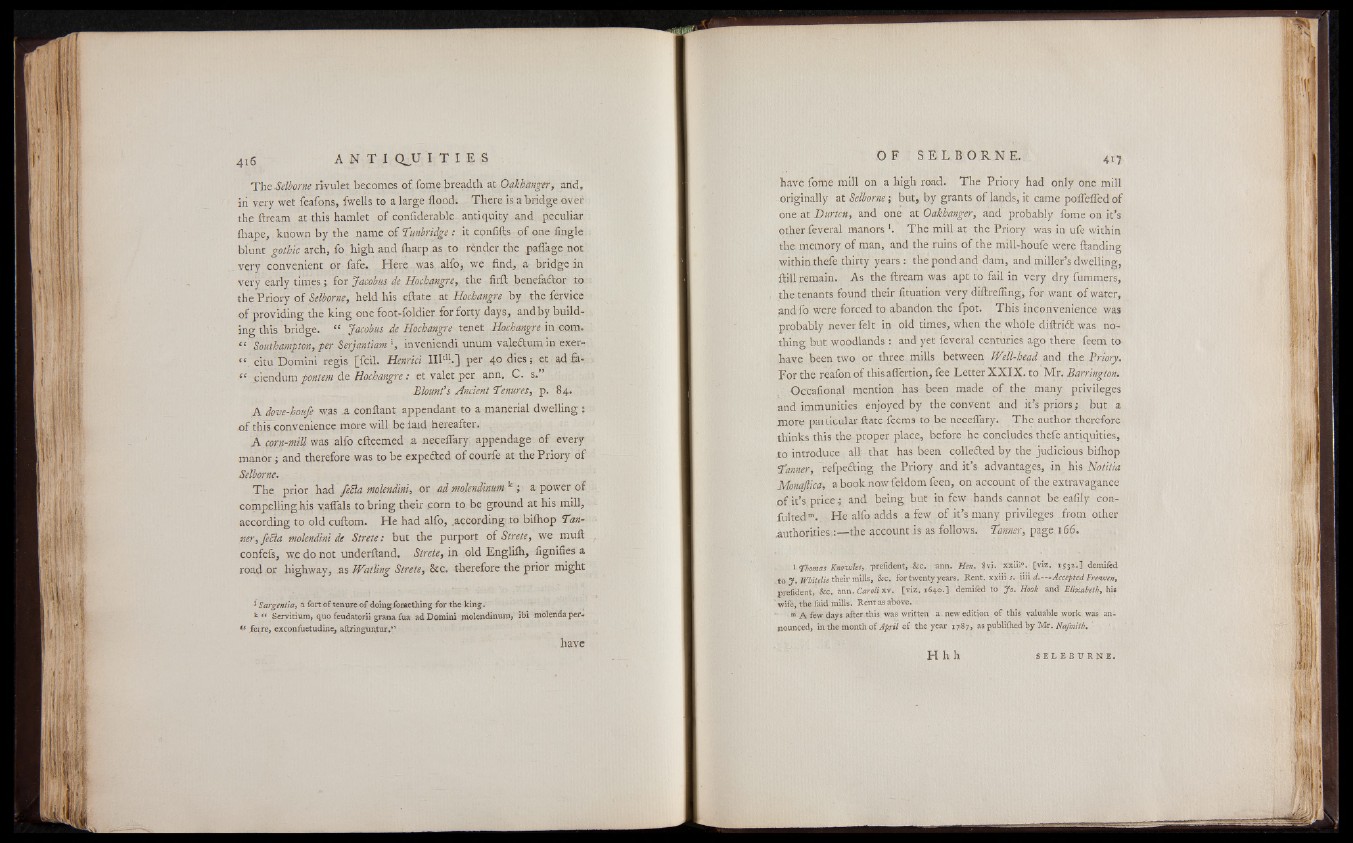
The Selborne rivulet becomes of fome breadth at Oakhanger, and,
iii very wet feafons, fwells to a large flood. There is a bridge over
the ftream at this hamlet of confiderable antiquity and peculiar
flrape, known by the name of Tunbridge : it confifts of one Angle
blunt gothic arch, fo high and fliarp.as to render the paflage not
very convenient or fafe. Here was alfo, we find, a bridge in
very early times; for Jacobus de Hochangre, the firft benefaflor to
the Priory of Selborne, held his eftate at Hochangre by the fervice
of providing the king one foot-foldier. for forty days, andby building
this bridge. “ Jacobus de Hochangre tenet Hochangre in.com.
“ Southampton, per Serjantiam !, inveniendi unum valeftumin exercitu
Domini regis [foil. Henriet HI''1';.] per 40 dies; et ad fa-
ic cicndimiponton de Hochangre: et valet per ann. C. s.
Blount’s Ancient Tenures, p. 84.
A dove-houfe w.as a .conftant appendant to a manerial dwelling :
of this convenience more will be faid hereafter-.; .
A corn-mill was alfo efteemed a neceflary appendage of every
manor; and therefore was to be expedted of courfe at the Priory of
Selborne.
The prior had feUa molendini, or ad snolendinum^ ; a power of
compelling.h.is yaflals to bring their porn to be ground at his mill,
according to old cuftom. He had alfo, .according to bilhop Tanner,
felia molendini de Strete: but the purport of Strete, we muft
coqfefs, we do not underftand. Strete, in old Englilh, fignifies a
road ,or highway, as Watting Strete, &c, therefore the prior might
1 Sargentia, a fort o f tenure o f doing foraethin g for the k in g .
k “ Servitium, quo feudatorii grana fua ad Domini molendinum, ibi molendaper-
“ fe:re, exconliietudine, aftrjnguntur.”
have
have fome mill on a high road. The Priory had only one mill
originally at Selborne; but, by grants of lands, it came poflefled of
one at Durtcn, and one at Oakhanger, and probably fome on it’s
other foveral manors *. The mill at the Priory was in ufe within
the memory of man, and the ruins of the mill-houfe were ftanding
within thefe thirty years : the pond and dam, and miller’s dwelling,
ftill remain. As the ftream was apt to fail in very dry fummers,
the tenants found their fituation very diftrefling, for want of water,
and fo were forced to abandon the fpot. This inconvenience was
probably never felt in old times, when the whole diftrict was no-
diino- but woodlands : and yet feveral centuries ago there feem to
have been two or three mills between Well-head and the Priory.
For the reafonof thisafiertion, fee Letter XXIX. to Mr. Barrington.
Occafional mention has been made of the many privileges
and immunities enjoyed by the convent and it’s priors; but a
more particular ftate feems to be neceflary. The author therefore
thinks this the proper place, before he concludes thefe antiquities,
to introduce all that has been collected by the judicious bifhop
Tanner, refpefting the Priory and it’s advantages, in his Notitia
Monajlica, a book now feldom feen, on account of the extravagance
of it’s price ; and being but in few hands cannot be eaAly con-
ful'ted1”. He alfo adds a few of it’s many privileges from other
.authorities.:— the account is as follows. Tanner, page 166.
1 fbamas Km’wtes, prefident, -&c. -ann. Hen. 8vi. xxm°. [viz. 153a.] demifed
-to 7. Wbitelie their mills, See. for twenty years. Rent, xxiii s. iiii d.—-Accepted Fre^wen,
prefident, &c. ann. Caroli xv. [viz. 1640.] demifed to Jo. Hook and Elizabeth, hi*
wife, the faid mills. Rent as above.
m few days after this was written a new edition o f this valuable work was announced,
in the month o f April o f the year 17.87, as publilhed by Mr. Nafmith. '
H h h S E L E B Ü R N E .